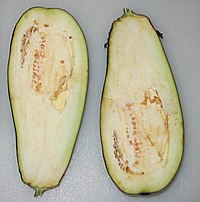Solanum melongena
Solanum melongena or eggplant is a plant with edible fruit, generally annual, of the genus Solanum within the nightshade family.
History
Did you mean: Su cultivo es antiquísimo, desde antes del 2000 a. C. y existen innumerables documentos escritos donde sitúan su origen en el sudeste asiático.The oldest known data establishes it in the state of Assam (northeast of India, Burma and China). Carried by Arab traders, it passed to North Africa and later, in the Middle Ages, it entered Europe through Muslim Spain, from where its cultivation spread throughout the warm countries of the Mediterranean.
It is very possible that due to lack of knowledge of how to treat eggplant culinaryally or by using inedible species it caused digestive problems, creating a bad reputation. During the first centuries of entry into Europe, there was a belief that its consumption caused multiple diseases such as fever, epilepsy and madness, which is why the plant was used for a long time as a decorative and exotic ornament and not as food. The famous Swedish botanist Carlos Linnaeus gave it its current scientific name Solanum melongena.
The first documentation about eggplant in the Spanish language is found in the book called Cancionero de Baena (from the century XV) where he cites its uses and virtues. It was introduced to America by the Spanish.
Where it is produced it is widely consumed. The world's largest eggplant producers are China and India. It is also produced in Japan and in various Mediterranean countries such as Spain, Italy and Greece.
International Eggplant Day is December 21.
Description


General
Annual herb, sometimes perennial, thorny, pubescent, with stellate hairs. Stems 30-70(200) cm, erect, branched, thorny or unarmed, stellate-pubescent. Leaves 70-150(250) by 30-100(180) mm, ovate or oblong-ovate, obtuse or acute, subcordiform, entire, sinuate or with 5-6 lobes, densely stellate-pubescent, especially on the underside; petiole 2-8 mm, stellate-pubescent, sometimes with some fine spines. Inflorescence in umbelliform cymes, isolated, pauciflorous, generally reduced to a single flower, sessile, extra-axillary, rarely opposite the leaves. Floresrami actinomorphic, hermaphroditic or functionally male, without bracts, pediceled; Pedicels 15-40 mm in flowering, and 5-18 mm in fruiting, sometimes spiny, not articulated. Calyx 13-20 mm, campanulate, with 5-9 lobes, very accrecent in hermaphrodite flowers, spiny; tube about 5 mm, shorter than or equal to the lobes; lobes 8-15 mm, lanceolate, acuminate, sometimes unequal. Corolla (25)30-45(50) mm in diameter, 2 times the length of the calyx, rotaceous, with 5-8 lobes, blue, violet or purplish; ovate lobes. Stamens 5-7(8), equal, with filaments of 0.6-2 mm, united at the bottom, with the distal part free, shorter than the anthers, glabrous; anthers 6-8 mm, ellipsoid, yellowish connivents. Ovary stellate-pubescent with cylindrical style, widened at the apex, stellate-pubescent in lower 3/4, exserted and compressed stigma, depressed in the center. Fruit measuring 50-200(300) by 50-100(150) mm, exceeding the calyx 2-5 times, subglobose, ellipsoid, ovoid, largely pyriform or more rarely spherical, fleshy, glossy, violet, purplish, yellow, blackish or a variegated white-violet. Seeds 3-4 by 2-5 mm, discoid or subreniform, compressed, pale yellow or light brown.


Fruit
The edible fruit is a berry 5 to 30 cm long, cylindrical, oblong or elongated in most cases, with a smooth, shiny skin of various colors depending on the variety. The most common is purple or black when ripe, but there are white, purple, black, yellow and red or mixed colors, especially white, black, purple and green. The pulp is consistent, spongy in texture, white in color, has a certain bitter flavor and has small yellow seeds. It is found all year round as it is grown in the greenhouse during low temperatures.
Anthocyanins (flavonoids) have been identified in the skin of the fruit, pigments that give it its purple color.
Varieties
Varieties and hybrids are usually classified by the shape of the fruit. Here, some more well-known ones.
- Long fruit: Long black long - Long abode - Violeta de Barbentane - Croisette;
- Round fruit: New York Violet - Almagro (for wrapping);
- Ovoid fruit: Gang Jasper (also called Javea List) - Mission Bell - Black Beauty - Blacknite - Bonica - Florida Market.
Fruit conservation
It should be stored in a refrigerated place until consumed and should be consumed as soon as possible (it lasts a little over ten days), since the fruit soon develops brown spots and begins to turn bitter. However, there are pickling procedures that allow this period to be extended for a year. It is very popular in Spanish cuisine and its final product is Almagro eggplants.
Nutritive properties
Its energy and nutritional value is small compared to other fruits, vegetables and vegetables. It contains few vitamins, carbohydrates, proteins and minerals, the majority component by weight being water, 92% of its composition. The most abundant mineral is potassium and in small quantities phosphorus, calcium, magnesium and iron. It has vitamins A, B1, B2, B3, C and folates.
It has a medium fibrous content but distributed more in skin and seeds. Its calorie content is almost non-existent.
Nutritional contribution table
Eggplants contain substances such as amines (serotonin and tyramine) that can cause allergic reactions and headaches in some sensitive people.
Kitchen

Debe comerse siempre cocida, nunca cruda.
Eggplant is a culinary product highly appreciated by different cultures. Many nations have a typical dish made from eggplant. In Spain, the Andalusians and La Mancha have the alboronía, the Catalans have the samfaina, the escalivada or the espencat where the eggplant is accompanied by the pepper, Italians have caponata, parmigiana (one of the most famous dishes with Greek moussaka), gli scapici i> (preserved in oil typical of southern Italy), the Greeks have the moussaka, the Turks have the İmam bayıldı and the Arabs have the baba ganush i>.
Roasted or sautéed it has a pleasant flavor, but not so when boiled. It is also consumed stuffed. If it is going to be prepared steamed, it is advisable to make a dégorger [2] which consists of cutting it into slices and causing an osmosis phenomenon by adding salt. In this way, liquids are exchanged so that the compounds that give it a bitter taste come to the outside, since the liquid flees from where there is less density to where there is more, also enhancing its pleasant flavor, which is determined by insoluble substances.
If you want to fry it, it is recommended to submerge the eggplant pieces in salted water for 24 hours. Since the texture of the pulp is very cavernous—full of air and water—if it is fried directly it acts like a sponge, absorbing a large amount of oil, and with it excessive calories. But after being introduced into this saline solution, this effect disappears and the eggplant, saturated with water, barely absorbs oil.
Medicinal



Certain flavonoids (skin pigments) in eggplant have antioxidant properties, which is why it is recommended for the prevention of cardiovascular, degenerative diseases and cancer.
The fruit also contains statins that are used for the treatment of dyslipidemia (problems with fats) such as hypercholesterolemia, hypertriglyceridemia and others. Helps reduce cholesterol and prevent arteriosclerosis. It also reduces blood sugar levels, which is beneficial for diabetics.
The paste of the crushed fruit is used as a balm applied to sunburned skin.
It also calms rheumatic pain, taking the water from this fruit crushed in water and left to rest for a full day, drinking it as drinking water.
Eggplant toxicity
It is widely believed that raw eggplant is toxic. Eggplant contains, like all plants, defense molecules such as alkaloids. One of them is a glycosylated alkaloid, solasonine, in quantities too low to have a toxic effect. Like other similar alkaloids present in species of the genus Solanum, such as solanine from green potatoes (Solanum tuberosum) and tomatine from tomatoes (Solanum lycopersicum ), solasonine is not destroyed by cooking, but it is destroyed by frying at high temperatures, so it is advisable to eat it cooked even if its toxicity is low. Due to its high histamine content, some people may experience oral allergy to eggplant, characterized by itching, tingling and slight swelling in the lips, mouth and throat immediately after eating.
In July 2008, researchers at the Central Food Technological Research Institute in Mysore, India reported on a number of allergens specific to brinjal. They noted that most reactions are due to protein allergens unique to eggplants, with effects including hives, stomach problems and the life-threatening syndrome called anaphylaxis. Although less common, these researchers suggest that some non-protein compounds in eggplants may cause allergic reactions. These include the pigments that give fruits their color and phytosterols, steroid-like compounds that are naturally present in many plants.
Cultivation
It is a very demanding plant in terms of light, requiring 10 to 12 hours of light. It tolerates high temperatures well as long as there is adequate humidity and is very sensitive to cold. Its minimum biological temperature is 10 to 12 °C and the maximum is 40 to 45 °C, the optimal relative humidity ranges between 50% and 65%. Seed for planting is extracted from ripe fruits and require at least 21°C (70°F) soil temperature to germinate.
The eggplant cycle usually lasts nine to ten months; From the moment it is planted until the harvest begins, it usually takes 100 to 125 days, depending on the variety and season of cultivation.
Transgenic eggplant
On August 23, 2007, the seed company Mahyco developed a transgenic eggplant. The new variety contains the cry1Ac gene, which gives it resistance to harmful insects whose larvae affect the fruit and shoots. This variety will begin to be tested in India and its effects will be evaluated. The GEAC (Genetic Engineering Approval Committee), India's highest regulatory body for biotechnology, authorized a large-scale field trial. This is expected to reduce the use of insecticides and, therefore, a favorable effect on beneficial insects.
Related species and hybridization
The species most closely related to eggplant are Solanum incanum, Solanum melongena L., Solanum indicum, Solanum sanitwongsei, Solanum surattense, Solanum gilo, Solanum integrifolium and Solanum torvum. Solanum indicum, Solanum gilo and Solanum incanum are highly resistant to different pests that affect eggplant cultivation, for this reason they are attempted to be used in interspecific crossing programs with eggplant to include such characteristics in cultivation. However, the compatibility between such species is very variable and the possibility of achieving fertile interspecific hybrids is strongly determined by the species and population used.
Production
Taxonomy
Solanum melongena was described by Carlos Linnaeus and published in Species Plantarum 1: 186. 1753.
- Etymology
Ultimately, its common name comes from a word from the Dravidian languages of India, where the species is native, which passed into Persian as بادنجان ', and then into Arabic, باذنجان bēdinŷêna , and from there to Spanish at the beginning of the XV Century; said Arabic word is the origin of all the common names of the plant in Europe.
Solanum: generic name derived from a Latin word equivalent to the Greek στρνχνος (strychnos) to designate the Solanum nigrum (the &# 34;Hierba mora)—and probably other species of the genus, including eggplant—, already used by Pliny the Elder in his Historia naturalis (21, 177 and 27, 132) and, before, by Aulus Cornelius Celsus in De Re Medica (II, 33). It could be related to the Latin sol, -is, "the sun", because the plant would be typical of somewhat sunny places.
melongena: of Byzantine Greek origin that adapted the Persian bādinyān, referred to above, as μελιτζάνα, "melitzána" —still used today in modern Greek—, influenced by μελανο, "melano", 'black' -probably because of the color of the fruit- to name the plant. It would later pass into medieval Latin as melongena, later used by botanical Latin, literally meaning "Solanum eggplant"
- Accepted variety
- Solanum melongena var. Inerme (Dunal) Hiern
- Sinonimia
- Solanum esculentum Dunal
- Solanum melongena var. depressum L.
- Solanum melongena var. esculentum (Dunal) Nees
- Solanum melongena var. serpentinum L.